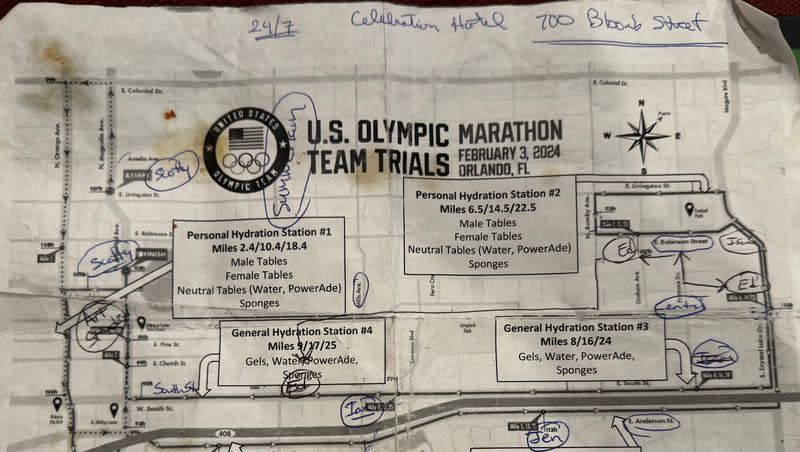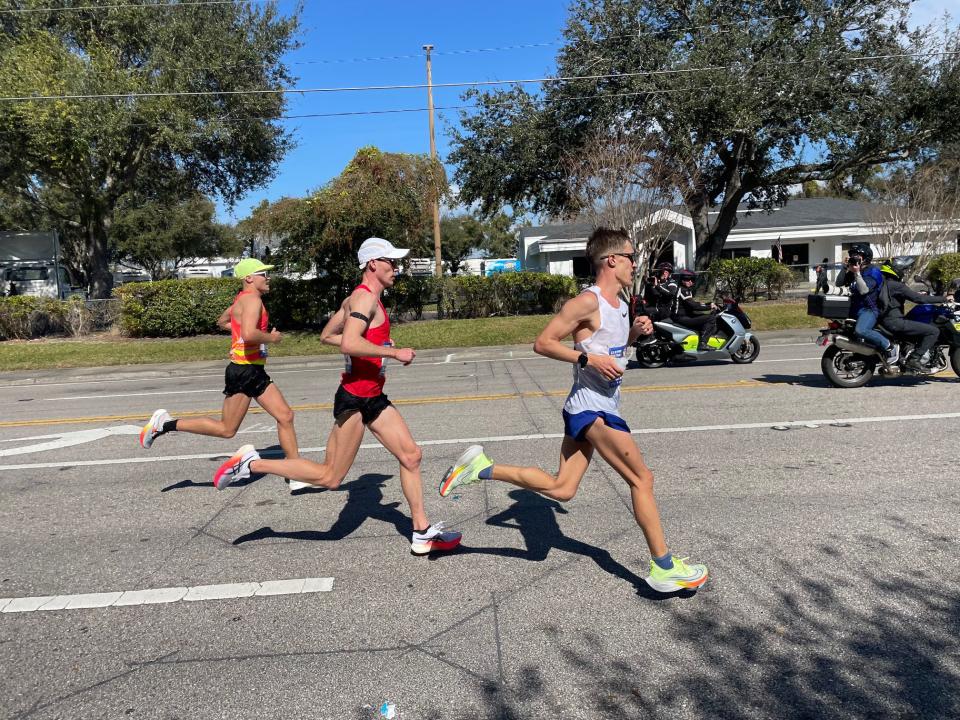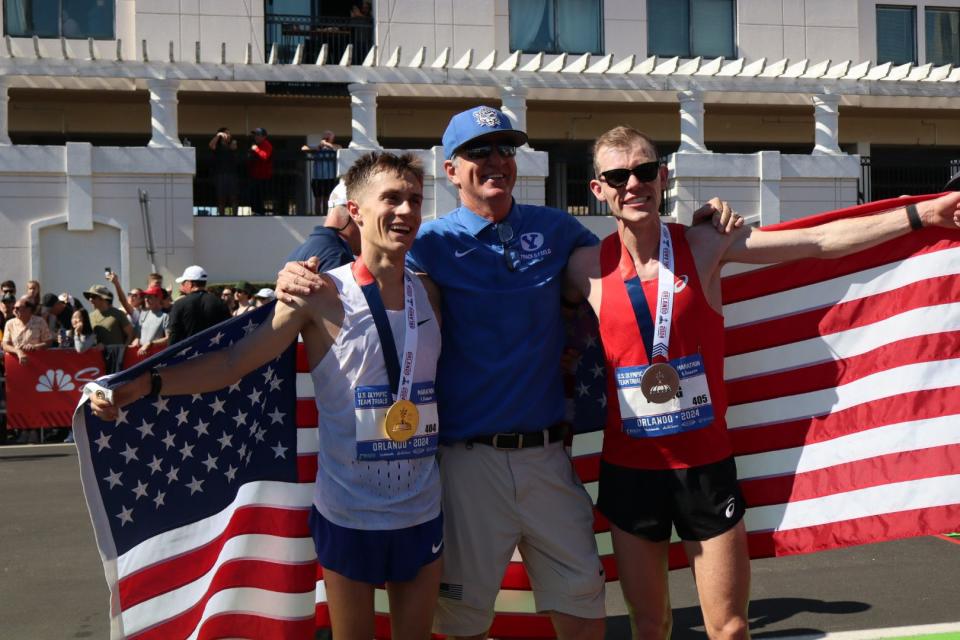Roadmap to Paris: BYU coach Ed Eyestone had a plan for Olympic trials — his two runners did the rest

- Oops!Something went wrong.Please try again later.
- Oops!Something went wrong.Please try again later.
It was 5 a.m. when Ed Eyestone gave up on trying to sleep and sat up in his hotel bed. Race day was here. He picked up his phone, took a photo of the sunrise and texted it to Conner Mantz and Clayton Young, who were waking up for breakfast in their hotel rooms hours before the U.S. Olympic Marathon Trials in Orlando.
“Beautiful sunrise right now,” he wrote. “It’s going to be an awesome day! You’ve done the work, now go enjoy the experience. Be present today … run the mile you are in and the result will take care of itself! You can do this! Chill, cover, close!”
“We all have great days in our lives. Mine were getting married, the birth of my six daughters … this will go down as a great day, too. I’ll have a smile on my face for the next five months.” — BYU track coach Ed Eyestone after watching Conner Mantz and Clayton Young finish 1-2 at the Olympic Marathon Trials
Eyestone was in an enviable position for a coach, but one filled with suspense and pressure. The opportunity to make an Olympic team comes only every four years and the 26.2-mile marathon is famously fraught with perils. Mantz and Young, two of the many accomplished runners who are coached by Eyestone, were the favorites by virtue of their performances in last fall’s Chicago Marathon. In that race they finished sixth and seventh overall, respectively — first and second among Americans — with the fourth and seventh fastest times ever by Americans — 2:07:47 and 2:08:00.
They had been training for months — really years — for the Olympic trials race. Both had continued to train with Eyestone after winning individual NCAA championships at BYU and then turning to the professional ranks. Unlike many runners who sign pro contracts with a shoe company, they decided to continue training with their college coach.
They are training partners and friends, although they sometimes describe their relationship as that of an old married couple, with the occasional spats, but it’s a functional, cooperative connection (Mantz and his wife have babysat Young’s children) and they have risen to the top of the running world together.
An Olympic berth is every runner’s dream, but what were the odds that both of them could make the team (a top-three finish)? Eyestone looked in the mirror as he shaved that morning, musing on the day ahead. “You get one guy in, it’s a good day, so be prepared for that,” he told himself, but deep in his heart he wanted it all. He wanted both Mantz and Young on the team. Badly.
Chill, cover, close
Eyestone prepared for the race the way he did for playing the lead role in a Christmas theatrical production of “A Christmas Story” in December, down to the finest detail, with the input of his runners.
Related
Conner Mantz, Clayton Young finish 1-2 at Olympic Marathon Trials
Here’s how other runners with Utah ties fared at Olympic Marathon Trials
Mantz and Young would wear caps filled with ice during parts of the race. They planned where they would grab water bottles. They planned where they would take water with caffeine. Eyestone planned brutal, difficult workouts. He met with his runners to discuss strategy and how to respond to different situations that could develop during the race. He created what he called a mantra for Mantz and Young: chill, cover, close. Chill — be patient early in the race (don’t get anxious and try to run away with it (it’s a long race). Cover — cover any moves the leaders make. Close — push the final miles, from about four miles out.
As it turned out, that is exactly what would happen.
“It could not have happened any better,” said Eyestone as he reminisced Sunday about the race. “If I had diagrammed it, that’s the way I would have drawn it up — start the first six miles pretty easy, at a fairly comfortable pace, then have someone take it out and push the pace and we cover those moves and drop the pretenders, and then in the last three to four miles our guys power away. This was my wish list.”
Mantz and Young eased through the first six miles — their mile splits: 5:01, 4:59, 4:57, 5:05, 5:06, 4:49. They ran with ease content to hang with the lead pack. Chill. “The way we get in trouble is when Conner bolts and tries to run away,” says Eyestone. “We wanted him to relax early on — chill — then cover any moves (by rivals).”
Breaking away
In the sixth mile, Zach Panning made that move and the real race was on. The pace dropped many of the so-called “pretenders” — runners who are able to hang with the lead pack because of a moderate pace and possibly steal the race with a hot finishing kick. The top runners want an “honest race” — a full 26-mile effort, not a mile kick. Anyway, racing is always easier for runners to run behind a pacer — this is why “rabbits” are hired for world record attempts — and Panning was a gift for Mantz and Young.
They covered his move, as did a dozen or so other runners. Panning continued to push the pace each mile — 4:49, 4:48, 4:47, 4:50, 4:49, 4:48, 4:52 — hitting the half-marathon mark in 1:04:08. There was still a pack of almost a dozen runners who had covered Panning’s move.

Eyestone was following the race on a rented bike, along with his wife Lynn, his daughter Andrea, team booster Todd Garner, former All-American Dustin Bybee and others. Eyestone frequently consulted a worn course map and raced to each spot to get a glimpse of the race. They spotted Mantz and Young boosters everywhere, 60-70 of them — former teammates, family, friends. Mantz’s supporters wore “Mantz Zone” T-shirts and Young’s crew wore orange tees. Many of them gathered at a course-side art gallery, which Garner had rented. There they could watch the runners pass by on the road (the race consisted of three eight-mile loops) and then return to the comforts of the gallery to watch the race on a big-screen TV.
The next three miles were the same — 4:52, 4:51, 4:51 — and then Panning, Mantz and Young laid down 4:48 and 4:44 miles and pulled away from the lead pack. They continued to widen the gap, covering the 19th mile in 4:53, 4:51, 4:59, 5:07, 5:07, and then Panning began to wilt. Mantz and Young covered the 24th mile in 5:10, Panning 5:29 (he would fade to sixth, but won respect from his peers for his bold, courageous effort).
Closing it out
The BYU duo had prepared just for this moment. In one of their recent workouts, they had run 25 hard miles, running the last four in 4:42, 4:43, 4:42 and 4:36. They ratcheted down the pace again: 5:03, 5:16, 4:50. The mantra was complete: close. They beat their nearest rival by 51 seconds. Their average race pace: 4:56 per mile.
They built such a big lead in the final miles that Young veered off to the side of the road looking for a flag to carry, but found none (“It was his only fail of the day,” Eyestone said wryly.). They were talking to one another (Mantz would later confess he couldn’t hear what Young was saying because of the crowd noise) and high-fiving one another.
Young looked like he was out for a fun run in the park, relaxed and smiling, but Mantz was hurting and laboring; then again, he always looks like he’s laboring. He has a very physical running style. Mantz is famous for his ability to run through pain — Eyestone calls it “The Mantz Zone” — but now he was hurting and doubting himself.
Related
“I don’t know if I can finish it,” he told Young, who told him, “Just run behind me. Just stay together.” He worried aloud that Young would pull away, but Young assured him that he would remain with him. In the last 100 meters Mantz edged in front of Young to win in 2:09:05, one second ahead of his training partner. Most observers agreed that Young let Mantz win. Eyestone himself speculated that Young, whom he affectionately calls “a hambone,” just wanted to enjoy the moment, waving to fans and exulting, “but Mantz just wanted it to be done.”
Eyestone also attributes it to the great respect Young has for Mantz, saying he would not be where he is today if he had not pushed him in their daily workouts.
At the finish, Eyestone posed for a photo with his two runners, smiling broadly. “It was nerve-racking,” he says. “That smile is 40% joy and 60% relief. We all have great days in our lives. Mine were getting married, the birth of my six daughters … this will go down as a great day, too. I’ll have a smile on my face for the next five months.”
Moment to remember
It was yet another milestone in the tremendous career of Eyestone and, for that matter, the rising reputation of running at BYU and in the state of Utah. BYU has claimed three of the last nine U.S. Olympic marathon berths — Jared Ward in 2016, Mantz and Young in 2024. That doesn’t count the two Olympic marathon berths that Eyestone himself won in 1988 and 1992. All four of the Olympians were returned church missionaries, raised in Utah and attended Utah high schools and BYU.
Eyestone turned to coaching when his long, illustrious professional running career ended, and he has made his mark there, as well. His BYU cross-country team won the 2019 NCAA Cross-Country Championships (he also hired Diljeet Taylor to oversee the women’s program and her team won the NCAA Cross-Country Championship two years later).
Young won the 10,000-meter run at the 2019 NCAA track and field championships, and Mantz won individual championships at the 2020 and 2021 NCAA Cross-Country Championships. Kenneth Rooks won the 3,000-meter steeplechase at last year’s NCAA and USA track championships and placed 10th in the world championships.
At last weekend’s Olympic marathon trials, BYU/Eyestone alums placed first, second, 13th, 21st and 49th in the field of 150 in the men’s race (Mantz, Young, Connor Weaver, Jacob Heslington and Nic Montanez, respectively) and another BYU alum was seventh in the field of 117 in the women’s field (Makenna Myler). Savannah Berry and Sarah Sellers, who once competed for Southern Utah and Weber State, respectively, were 12th and 14th.
“I need to add another C to the mantra — chill, cover, close … celebrate,” said Eyestone. “We need to enjoy this one.”


